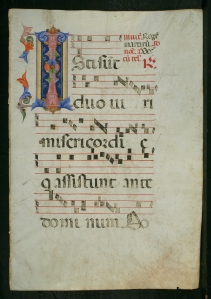I apologize for my prolonged absence! I’ve been in the UK (saw some of you at Leeds), but I’m back home now, ready to pick up where I left off. I was going to head up to Birmingham, Alabama this week, but my itinerary will actually take us through the Florida panhandle and down the West coast of the Sunshine State instead. We’ll get to Alabama in a few weeks.
The University of Florida in Gainesville has two interesting codices, leaves from both of which can be seen on this site, the results of a independent study in paleography and codicology at U. Florida. The first manuscript is a heavily-annotated thirteenth-century Bible from Italy (shown at right).
The second manuscript (below), a late fifteenth-century Cicero, is also Italian.
The Schoenberg Institute for Manuscript Studies at the University of Pennsylvania was not the only collection to benefit from the generosity of patron and collector Lawrence J. Schoenberg during his lifetime. Before his death last May, Larry lived with his wife Barbara Brizdle on the Gulf Coast of Florida, near Sarasota. Several years ago, they donated ten leaves and a codex to Sarasota’s New College, including a very nice S. German/Austrian Romanesque gradual leaf (formerly LJS 117). I worked for Larry in the 1990s, before he donated these manuscripts to the College, so I actually catalogued and studied them some twenty years ago.

New College, formerly LJS 106 (“Copyright New College of Florida. This image may not be used for commercial purposes or altered in any way.”)
The College very kindly sent me the image at right, formerly LJS 106, a leaf from a late fifteenth-century Book of Hours (I recognize my handwriting in the lower margin, where I wrote the Schoenberg shelfmark in pencil).
In nearby St. Petersburg, the Museum of Fine Arts has several fine leaves. See anything familiar?

Antiphonal, Italy, s. XV (Museum of Fine Arts, St. Petersburg, Florida, Gift of Lothar and Mildred Uhl, Acq. 2007.12.4 recto)

David at Prayer, opening of the Penitential Psalms (Museum of Fine Arts, St. Petersburg, Florida, Gift of Lothar and Mildred Uhl, Acq. 2002.20 recto)

Beauvais Missal (Museum of Fine Arts, St. Petersburg, Florida, Gift of David S. Hendrick III, Acq. 1979-11-1 recto)

Book of Hours (Museum of Fine Arts, St. Petersburg, Florida, Gift of David S. Hendrick III, acq. 1979-11-5)
Several features of the leaf at right, from a ca. 1430 French Book of Hours, immediately struck me as familiar: the red fillet border, the unusual form of the [g], and the pointed-oval leaves in the margin. A search through my computer for leaves from Books of Hours with 16 lines per page led me to a leaf I catalogued for Smith College earlier this year, MS 42.5.
Like the Beauvais Missal, these leaves come from a manuscript dismembered by Otto Ege, although they were not used in any of his portfolio collections. A third leaf from this manuscript is in Providence, RI, at the Rhode Island School of Design (MS 43.444) [n.b. the leaves at Smith and RISD had previously been identified as part of Ege’s FOL 46, but they are in fact from a different manuscript (see S. Gwara, Otto Ege’s Manuscripts, Handlist 46)]. The Museum’s Beauvais Missal leaf and this Book of Hours leaf were given by David S. Hendrick III in 1979 along with three others; some of these may turn out to have an Ege provenance as well. For example, I haven’t seen an image of manuscript 1979-11-2, a ca. 1470 Aquinas, but I suspect it might have come from Ege’s FOL 40 (see Gwara, Handlist 40).
 As we head east across the Florida peninsula, we’ll pass “The Happiest place on Earth.” There are no manuscripts that I know of in Disneyworld, but if you do go to Orlando to visit Disney or The Wizarding World of Harry Potter and you want to see some medieval manuscripts, make time for the faith-based theme park, The Holy Land Experience. This is where you will find a very impressive collection of early biblical manuscripts known as The Scriptorium, formerly the Van Kempen Collection. Some images are online here, although they are not very high resolution. Manuscript VK 783 is a 4th century Coptic manuscript known as Mississippi Coptic Codex II, and is the companion to Papyrus Bodmer XXII in Geneva; both have been studied here. The collection also contains very fine examples of Carolingian, Romanesque and Gothic manuscripts. You can download a nice image of their Wyclif Bible here.
As we head east across the Florida peninsula, we’ll pass “The Happiest place on Earth.” There are no manuscripts that I know of in Disneyworld, but if you do go to Orlando to visit Disney or The Wizarding World of Harry Potter and you want to see some medieval manuscripts, make time for the faith-based theme park, The Holy Land Experience. This is where you will find a very impressive collection of early biblical manuscripts known as The Scriptorium, formerly the Van Kempen Collection. Some images are online here, although they are not very high resolution. Manuscript VK 783 is a 4th century Coptic manuscript known as Mississippi Coptic Codex II, and is the companion to Papyrus Bodmer XXII in Geneva; both have been studied here. The collection also contains very fine examples of Carolingian, Romanesque and Gothic manuscripts. You can download a nice image of their Wyclif Bible here.
Several other Florida collections are worth noting, although they have no digital presence as yet: Florida State Universiy in Tallahassee, St. Leo Abbey in St. Leo, and the Ringling Museum in Sarasota.
Now we’ll turn northward and start making our way up the Atlantic coast.





